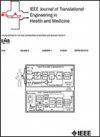Compliant Tibial Stem for Primary Total Knee Arthroplasty
IF 4.4
3区 医学
Q2 ENGINEERING, BIOMEDICAL
IEEE Journal of Translational Engineering in Health and Medicine-Jtehm
Pub Date : 2025-08-07
DOI:10.1109/JTEHM.2025.3596561
引用次数: 0
Abstract
Objective: Total knee arthroplasty (TKA) is a common and highly successful treatment for knee osteoarthritis. Despite its success, some TKA implants still do not last the remaining lifetime of the patient, due in large part to aseptic loosening of the bone-implant interface, most commonly involving the tibial component. In this manuscript, we present a compliant tibial stem with the potential to increase the lifespan of TKA by accommodating rotation of the tibial tray about the tibia’s long axis without introducing an additional high-cycle-count wear surface. Our objective was to refine the design of this implant to support the loads and displacements associated with common activities of daily living (ADLs), and to validate performance of a physical prototype on the benchtop. Methods: We used finite element analysis to sweep a representative parameter space of reasonably-sized caged hinges, and then to refine the mechanism geometry in the context of in vivo knee joint loads. We fabricated a prototype of the refined mechanism, and evaluated performance of that physical prototype under ADL loads and displacements. Results: The refined mechanism supports walking loads and displacements with a safety factor of 1.47 on the target fatigue stress limit. The maximum reaction moment in the prototype was 1.22 Nm during emulated walking, which represents a reduction of approximately 80% from the in vivo reaction moment within a conventional TKA implant rotating to the same angle. Discussion/Conclusion: Our results demonstrate feasibility of a compliant tibial stem with the potential to decrease failure rates and increase longevity of TKA implants.初次全膝关节置换术的顺应性胫骨干
目的:全膝关节置换术(TKA)是治疗膝关节骨性关节炎的一种常见且非常成功的方法。尽管取得了成功,但一些TKA植入物仍然不能维持患者的剩余寿命,这在很大程度上是由于骨-植入物界面的无菌性松动,最常见的是涉及胫骨部件。在这篇文章中,我们提出了一种兼容的胫骨干,通过调节胫骨托盘围绕胫骨长轴的旋转,而不引入额外的高循环数磨损表面,具有增加TKA寿命的潜力。我们的目标是改进这种植入物的设计,以支持与日常生活(adl)相关的负载和位移,并验证物理原型在工作台上的性能。方法:采用有限元分析方法,扫描具有代表性的尺寸合理的笼式铰链参数空间,然后在膝关节体内载荷的背景下细化机构几何结构。我们制作了一个改进机构的原型,并评估了该物理原型在ADL载荷和位移下的性能。结果:改进后的机构支持行走载荷和位移,其目标疲劳应力极限安全系数为1.47。在模拟行走过程中,原型中的最大反应力矩为1.22 Nm,比传统TKA植入物旋转到相同角度时的体内反应力矩减少了约80%。讨论/结论:我们的研究结果证明了柔性胫骨干的可行性,具有降低TKA假体失败率和延长其使用寿命的潜力。
本文章由计算机程序翻译,如有差异,请以英文原文为准。
求助全文
约1分钟内获得全文
求助全文
来源期刊

IEEE Journal of Translational Engineering in Health and Medicine-Jtehm
Engineering-Biomedical Engineering
CiteScore
7.40
自引率
2.90%
发文量
65
审稿时长
27 weeks
期刊介绍:
The IEEE Journal of Translational Engineering in Health and Medicine is an open access product that bridges the engineering and clinical worlds, focusing on detailed descriptions of advanced technical solutions to a clinical need along with clinical results and healthcare relevance. The journal provides a platform for state-of-the-art technology directions in the interdisciplinary field of biomedical engineering, embracing engineering, life sciences and medicine. A unique aspect of the journal is its ability to foster a collaboration between physicians and engineers for presenting broad and compelling real world technological and engineering solutions that can be implemented in the interest of improving quality of patient care and treatment outcomes, thereby reducing costs and improving efficiency. The journal provides an active forum for clinical research and relevant state-of the-art technology for members of all the IEEE societies that have an interest in biomedical engineering as well as reaching out directly to physicians and the medical community through the American Medical Association (AMA) and other clinical societies. The scope of the journal includes, but is not limited, to topics on: Medical devices, healthcare delivery systems, global healthcare initiatives, and ICT based services; Technological relevance to healthcare cost reduction; Technology affecting healthcare management, decision-making, and policy; Advanced technical work that is applied to solving specific clinical needs.
 求助内容:
求助内容: 应助结果提醒方式:
应助结果提醒方式:


